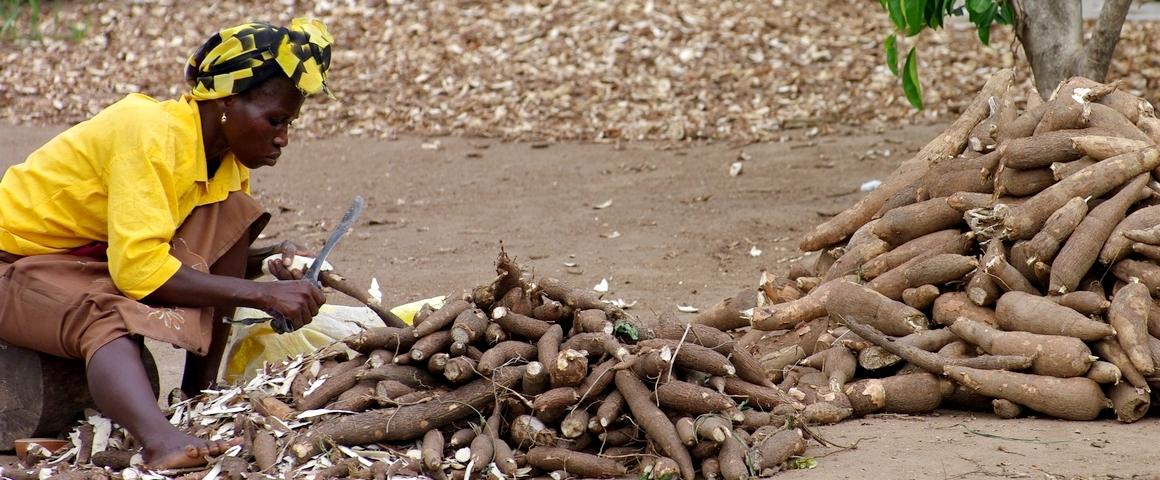Science at work 16 December 2025
- Home
- CIRAD news
- News
- Choosing new root, tuber and plantain varieties
Roots, tubers and bananas: if you want a useful variety, ask a consumer!

Peeling cassava in Nigeria © D. Dufour, CIRAD
Roots that are difficult to peel, tubers that take too long to cook and bananas with no taste... in recent years, many varietal breeding programmes have had the unpleasant surprise of seeing new varieties developed for their disease- or drought-resistance fail to be adopted. The main reason is that those plants did not meet the requirements of "end users": consumers and processors.
Unfortunately, creating new varieties is a long, costly undertaking. To boost food security, varietal breeding operations therefore need to be both effective and efficient. In 2018, the Bill & Melinda Gates Foundation launched a range of projects focusing on roots, tubers and plantains. CIRAD was tasked with a project devoted to understanding and assessing the quality traits consumers look for: the RTBfoods project.
"We have been able to pinpoint the most sought-after characteristics for these products, in terms of texture, colour, taste and aroma", says CIRAD's Dominique Dufour, who is coordinating the RTBfoods project. "We can now share concrete methods for including those quality criteria in varietal breeding programmes, alongside the usual agronomic criteria." The results have been published on open access in a special issue of the Journal of the Science of Food and Agriculture, compiling the work done by more than 150 authors from 15 countries, mostly in sub-Saharan Africa.
Consumer requirements are central to food security
Almost 350 million tonnes of roots, tubers and bananas are produced and consumed in Africa each year. Yams, plantain bananas, sweet potatoes, matookes, taros and cassava are central to diets throughout the tropics and contribute to rural and economic development in the regions concerned.
The trouble is that these crops suffer from a lack of genetic diversity, making them highly sensitive to climate change and diseases. There is therefore a vital need for new disease-resistant local varieties suited to current-day climate hazards, to boost food security for large numbers of people. However, agronomic performance is not everything. As Dominique Dufour points out, "whether or not a variety is useful primarily depends on its acceptability to consumers and processors; In sub-Saharan Africa, it is often women who cook, and they have certain preferences in terms of taste, processability and cooking methods. We saw exactly the same thing in France: very firm, easily transportable tomato and strawberry varieties were developed at one stage, but they proved tasteless and were eventually abandoned."
Over more than four years, the transdisciplinary team led by CIRAD conducted laboratory tests and surveys in rural communities in sub-Saharan Africa, to pinpoint the characteristics consumers see as vital. A dozen local agricultural products came under close scrutiny, including sweet potatoes, yams, plantains and cassava. The team concluded that the key was for varieties to satisfy consumers, even if their agronomic performance was not so good.
"We obtained these results thanks to our African scientific partners and breeders, but also nutritionists and gender specialists", Dominique Dufour explains. "We are proud of our results, which will have a concrete impact on varietal breeding of these crops, hence on improving living conditions for rural people."
The dialogue started by RTBfoods has served to establish regional scientific solidarity in sub-Saharan Africa. The aim now is to build on that solidarity in order to improve methods even further and achieve a broad diversity of varieties of root, tuber and banana crops to match up to current local demand.
Read the special issue
Journal of the Science of Food and Agriculture: Volume 104, Issue 8. Special issue: Tropical roots, tubers and bananas: New breeding tools and methods to meet consumer preferences




























